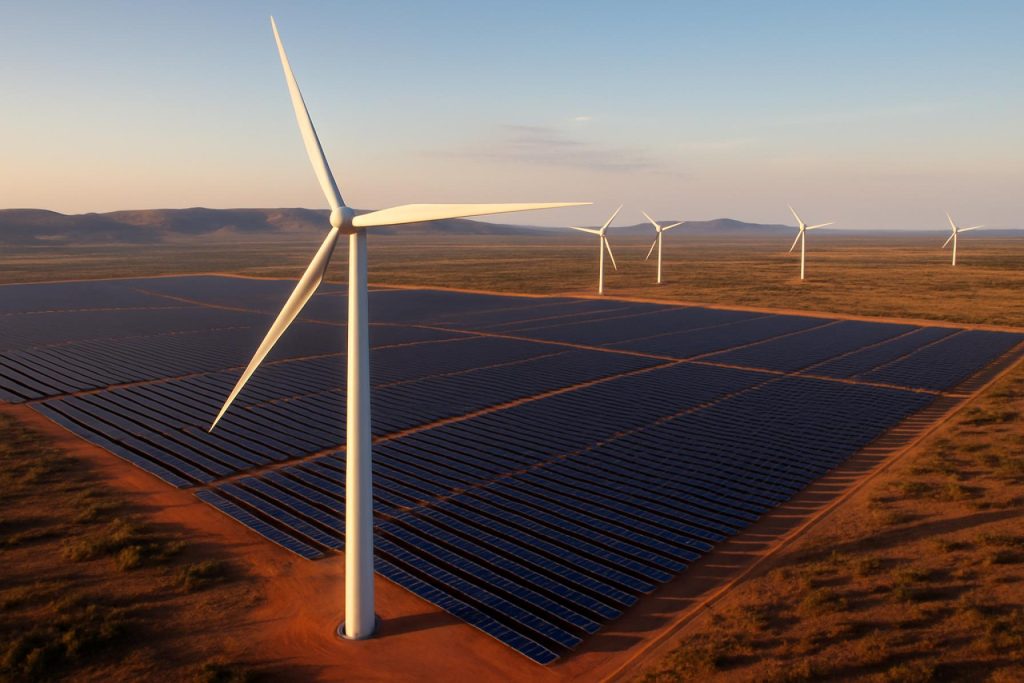
- Warradarge Energy and Xodus are developing one of Australia’s largest green hydrogen and ammonia projects in Oakajee, Western Australia.
- The initiative will utilize over 16,000 hectares and aims to decarbonize the mining and heavy transport sectors by supplying domestic green hydrogen.
- Future stages will focus on green ammonia production for export, targeting key international markets in Asia, Europe, and North America.
- Australia’s abundant wind and solar resources, plus access to competitively priced energy, position Oakajee as a crucial player in the global hydrogen supply chain.
- This large-scale project accelerates timelines, reduces costs, and propels Western Australia to the forefront of the global clean hydrogen revolution.
Tidal winds sweep across the sprawling Mid-West of Western Australia, stirring more than desert dust—they now signal seismic change. Under the relentless West Australian sun, global energy advisory Xodus, together with ambitious partners, has secured a formidable slice of land in the Oakajee Strategic Industrial Area. The goal: to forge one of the largest green hydrogen and ammonia operations Australia has ever seen.
Xodus isn’t just chasing a distant vision; their boots are firmly in Oakajee’s red soil. The project, operating under the new banner of Warradarge Energy, aims to stun the globe by turning over 16,000 hectares—an area ten times the size of Manhattan—into the linchpin of a new clean energy supply chain. The intricate groundwork is already underway: power supply negotiations hum with the local wind farm, and a network of buyers stands ready to tap into a renewable hydrogen pipeline that could fuel Western Australia’s colossal mining trucks and the heavy transport sector.
This is not a pilot plant. The game plan unfolds in masterful stages. First, the team will deliver domestic green hydrogen—pure, clean energy capable of transforming the carbon-heavy veins of Australia’s mining industry. By replacing diesel across remote mine sites, the project tackles Australia’s biggest emissions head-on. It is an audacious pivot from past, fossil-fueled practices.
But the blueprint extends beyond Australia’s borders. Future phases will see the facility brewing ammonia for export, a crucial development as Asia, Europe, and North America race to lock down alternative fuels for shipping, power generation, and even fertilizer production. Oakajee’s proximity to deepwater ports and renewable resources positions it perfectly for this seismic pivot.
The scale and vision of the initiative are matched only by its economic gravity. Australia’s hydrogen market already approaches $225 billion, thanks to its bountiful wind and solar reserves. Here, Warradarge Energy leverages that advantage by securing competitively priced, behind-the-meter energy, thus slashing production costs for green hydrogen—a long-sought breakthrough for global markets hoping to shed their reliance on gas and coal.
Industry leaders at Xodus and Warradarge Energy see this as the missing link between the demonstration-scale experiments of yesterday and the gigawatt-scale, globally-connected hydrogen backbone of tomorrow. By blending engineering rigor with bold ambition, they are crafting a supply chain that accelerates timelines, cuts costs, and ensures the stakes match the scale of the climate crisis.
Western Australia, long a juggernaut of mineral exports, now sets its sights on becoming a titan of the clean hydrogen revolution. As global markets wake up to the necessity of decarbonization and new technologies race from lab to landscape, the windswept lands of Oakajee may soon host the keystone projects that will power the world beyond fossil fuels.
Key takeaway: The rise of green hydrogen in Western Australia signals more than a local energy project—it’s a turning point in the global transition to sustainable power, with Warradarge Energy and Xodus at the forefront. For those tracking the world’s next energy superpowers, all eyes should be on the red earth of Oakajee.
For a deeper look at Australia’s expanding hydrogen ambitions and global energy trends, visit energy.gov.au.
Unveiled: How the Oakajee Hydrogen Project Puts Australia on the Fast Track to Renewable Energy Superpower
The Oakajee Green Hydrogen and Ammonia Project—What You Need to Know
Western Australia’s Mid-West is the center of global attention with the launch of the Oakajee green hydrogen and ammonia development by Warradarge Energy and Xodus. While the source article shines a light on the bold vision, let’s dig deeper into the project’s impact, technology, global positioning, and what it means for investors, the local community, and the clean energy market as a whole.
—
Untold Facts & Expert Insights
1. What Makes Green Hydrogen from Oakajee Distinct?
– Truly Green Energy: Unlike “grey” (from natural gas) or “blue” (from natural gas with carbon capture) hydrogen, the Oakajee project exclusively uses wind and solar power—ensuring zero lifecycle emissions from hydrogen production ([IEA Report](https://www.iea.org)).
– Massive Scale: At over 16,000 hectares, Oakajee is a frontrunner in the global race for gigawatt-scale hydrogen, a huge leap beyond typical 10-50MW demonstration plants.
– Integrated Value Chain: The co-produced green ammonia (used as fertilizer, fuel, or chemical feedstock) turbocharges export revenue, diversifying Western Australia’s resource economy.
2. How Will the Technology Work?
– Electrolysis at Scale: Oakajee’s hydrogen will be produced using PEM (Proton Exchange Membrane) and potentially alkaline electrolyzers—technologies selected for their efficiency at renewable energy integration.
– Direct Renewable Supply: “Behind-the-meter” supply from co-located wind and solar slashes energy costs by avoiding transmission fees.
– Export Readiness: Ammonia production will employ Haber-Bosch synthesis retrofitted for green hydrogen feedstock, making shipping and global logistics practical ([BloombergNEF](https://about.bnef.com)).
3. Real-World Use Cases & Market Trends
– Decarbonizing Mining: Heavy-haul trucks and remote mine sites can be converted to hydrogen power—major companies like Fortescue Metals Group are piloting hydrogen vehicles right now in WA.
– Shipping & Fertilizer: Green ammonia is emerging as the fuel for zero-emissions shipping—Maersk and NYK Line are already investing in ammonia-ready vessels.
– Power Generation: Utilities in Japan and South Korea are blending green ammonia into coal-fired plants to cut emissions ahead of strict 2030 targets.
4. Security, Sustainability & Industry Forecast
– Australian Hydrogen Market Outlook: According to CSIRO and energy.gov.au, Australia could capture up to 20% of global hydrogen exports by 2040.
– Supply Chain Resilience: Owning domestic renewable resources protects Australia from volatile global gas prices and geopolitical risk seen in oil and gas.
– Jobs & Community: Projects like Oakajee are estimated to create thousands of construction and ongoing STEM jobs in WA (Deloitte 2021 Report).
5. Pricing, Features & Comparisons
– Production Cost Targets: Oakajee aims for green hydrogen below AUD$2/kg—a price point where hydrogen can outcompete diesel and natural gas in many applications (Hydrogen Council Benchmark).
– Competitive Edge: By leveraging WA’s sunshine and wind, costs can be 15-25% below global averages—critical for outbidding Middle Eastern or North American rivals.
6. Limitations & Controversies
– Water Scarcity Issues: Electrolysis requires large volumes of pure water—a potential challenge in WA’s arid Mid-West; desalination or water recycling technology will be pivotal.
– Grid Impact: Massive new renewables can stress local infrastructure; grid enhancements are needed for reliability and export integration.
– First-Mover Risk: Scale, technology shifts, and global competition mean commercial success is not guaranteed—government support and policy consistency are crucial.
7. Security & Environmental Considerations
– Land Stewardship: Environmental approval will require rigorous wildlife and heritage impact assessments.
– Indigenous Partnerships: Meaningful engagement with First Nations communities is key for access, benefit-sharing, and project legitimacy.
—
Pressing Questions Answered
Q: Will green hydrogen be affordable for average businesses and the public?
A: As production scales and technology matures, experts forecast prices dropping significantly by 2030, making it competitive for mining, trucking, and even public transport ([IEA, 2023]).
Q: Is the Oakajee facility export-focused or will it supply domestic users?
A: Both—the initial focus is supplying domestic heavy industry, but global export markets (Asia, Europe, North America) are the long-term prize.
Q: Can green hydrogen help Australia achieve its 2050 net-zero targets?
A: Yes—with projects like Oakajee, green hydrogen can decarbonize steel, ammonia, trucking, and power—all critical sectors for meaningful emissions reduction.
—
Actionable Quick Tips & Recommendations
– Invest or Get Involved Early: Companies and individuals can tap into grants and research partnerships tied to the Oakajee project with proactive engagement.
– Upskill for Hydrogen Jobs: STEM, engineering, logistics, and environmental science professionals should consider hydrogen-centric skills development.
– Track Policy Developments: Monitor updates from energy.gov.au and state government for incentives and regulatory opportunities.
– Sustainable Water Use: Support or advocate for projects that use seawater desalination or recycled sources to minimize freshwater impact.
—
Pros & Cons Overview
| Pros | Cons |
|——————————————-|————————————–|
| Large-scale GHG emissions reduction | High water demand |
| Economic diversification and new jobs | Upfront capital investment is large |
| Export potential to key international markets | Technology and policy risk |
| Global leadership in renewables | Environmental and social licensing |
—
Final Word
The Oakajee Hydrogen Project is a landmark step in Australia’s—and the world’s—clean energy revolution. By driving down costs, pioneering technology at scale, and setting a global example, Western Australia has a real shot at reimagining its economic future. If you’re a policymaker, investor, engineer, or job-seeker, now is the time to ride the renewable wave—or risk being left behind.
For authoritative updates, research, and government guidance, visit Xodus and energy.gov.au.



